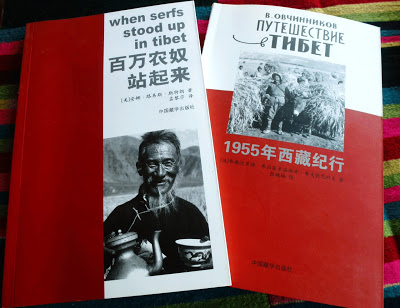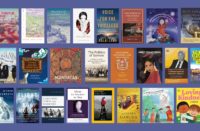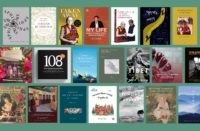
High Peaks Pure Earth has translated a blogpost by Woeser written in July and August 2013 for the Mandarin and Tibetan services of Radio Free Asia and published on her blog on August 14, 2013.
This article is a follow up to her previous post “Remembering Groups of Foreign Journalists Visiting Tibet in 2008” and looks at state-managed visits to Tibet for foreign journalists throughout the years. Woeser focuses on two Chinese language publications in translation of accounts by foreigners who visited Tibet in the 1950s.
Whilst Anna Louise Strong passed away in 1970, Vsevolod Ovchinnikov can still be found in Chinese state media, such as in these articles of 2009 here and here where he says he travelled to Tibet for the second time in 1990.
“A Group of Foreign Journalists ‘Visits’ Tibet in the 1950s”
By Woeser
There is a long tradition of the CCP organising official visits to Tibet for groups of foreign journalists. This is the conclusion I drew from reading two translated books published by the China Tibetology Publishing House.

One book is called “Travel Notes from Tibet in 1955”, originally written in Russian by the journalist Vsevolod Ovchinnikov who was working for Pravda, a newspaper from the former Soviet Union. At the time, on invitation of China’s Premier Zhou Enlai, organised and led by the Information Department of the Chinese Ministry of Foreign Affairs, journalists from Communist countries such as the Soviet Union, Eastern Germany, Poland, Czechoslovakia as well as a few CCP-friendly western journalists went to visit the “liberated” Tibet. This book reads like a report by Chinese state media written for foreigners, using the mouth of a foreigner to tell the world what the CCP plans to do after having occupied Tibet for five years. In Lhasa, this group of journalists also met the 20-year-old Dalai Lama. If the records of His Holiness’ words in this book are correct, one can clearly recognise that the short, scripted sentences of the Dalai Lama were only an act of politeness. Being the spokesperson of the occupied people, he had no alternative but to act in this way.
Hostility towards and degradation of religion is a main character trait of Communist Party members. As a journalist of the notorious Soviet Union government newspaper – Pravda – Ovchinnikov did not try to conceal this. When he saw the religious murals in the Potala Palace and in monasteries all over Tibet, he described them “as pockmarks on sick people’s faces”.

The other book is called “When Serfs Stood up in Tibet”, originally written in English by the CCP-friendly journalist Anna Louise Strong. She first came to China during Japanese occupation and went to Yan’an to interview the recovering Mao Zedong and his army that was waiting to take further action; that’s when she gained Mao’s trust and support. In 1958, she settled down in Beijing. In 1959, several months after the Tibetan uprising had been suppressed and the Dalai Lama had been forced into exile, the Chinese State Council gave special permission to the Ministry of Foreign Affairs and the People’s Daily to lead a group of 19 journalists from Communist countries as well as CCP-friendly journalists to visit the “liberated” Tibet. Anna Louise Strong, who was already 70 years old, was one of them. These journalists enjoyed all kinds of privileges, as she describes in her book. When they were flying to Lhasa, they were taking a special “deluxe airplane model” and when they were visiting Norbulingka they were greeted by cheering Tibetans lining the streets.
Hence, this book does not possess any real journalistic character at all, it is neither objective nor true, between the words and lines one can read the “voice of Tibet” as propagated by the Chinese Propaganda Department. What is even more absurd is that this self-confident old lady writes about the Chinese troops shooting down the Tibetan uprising in March 1959 as “the rebel artillery began their all-out attack (…). Bursts of fire came from Potala Palace, from Norbulingka, from Chagpori, the highest point in Lhasa.” She even said that the Mentseekhang Medical School that had clearly been burnt down by the PLA was actually destroyed by “armed rebels”. She also greatly “appreciated” the “public denunciation meetings” that were so typical for the CCP. These “denunciation meetings” that were initiated by Party cadres were full of violence. In all parts of China these meetings have resulted in the deaths of countless people who were classified as “class enemies”; in Tibet in this way many important people were eliminated.
What needs to be added is that in comparison to today’s groups of journalists who are arranged to visit Tibet, the difference is that today there are basically no Communist countries left; the world has changed a great deal, the Soviet Union has turned into Russia, Eastern Germany has become part of Germany, Czechoslovakia has been separated into two democratic countries. If the CCP wanted to invite people from the same camp to visit Tibet, there would only be a handful of powerless countries like Cuba or North Korea. Of course, they are not that stupid, now they invite non-Communist countries who are easy allies or with whom there has long existed a tacit agreement.
But there are also similarities. For example, the content of these visits is more or less the same as it was 50 years ago, they must all interview the “emancipated serfs” who had been “filled with great bitterness”, who denunciate the “old Tibet” and praise the happiness of the “new Tibet”. The interview itinerary back then was even shockingly similar to the one today; if they, for example, visit a revived aristocratic manor, “emancipated serfs” selected by the Party would be waiting for them.
In reality, however, when these two groups of foreign journalists visited Tibet, in the entire Tibetan region protests were forming or had already erupted or the army would be in the midst of conducting massacres in the name of “putting down a revolt”. The Tibetologist Elliot Sperling analysed a gender ratio graph obtained from a 1982 census: “… the Tibetan Plateau had a widespread imbalance between males and females, an imbalance that can really only be explained by violent struggle.” “One simply cannot know the exact number without free access to Chinese records. But the fact that a large-scale slaughter took place ought to be unquestioned.”
July – August 2013
All photos below are taken from the two books “When Serfs Stood Up in Tibet” and “Travel Notes from Tibet in 1955” (both were published by the China Tibetology Publishing House).










Hi Woeser,
I met a foreign photographer who went to Tibet with Xinhua in 1956 and 1959, Eva Siao (maybe one of the 19 on the 1959 trip). At that time she broadly accepted the Communist Party’s propaganda about “liberation” of Tibetans. When I interviewed her in 1999, she was nearly 90. She remembered finding that Tibetans were “very free people.”
I told her I had recently returned from my first trip to Tibet. Later, she asked me: “Is it really like they say it is?” I replied: “Yes, I think it is.” There seemed little need to say any more.
我见过一位这种外国记者,她为新华社当摄影师1956年和1959年两次去拉萨 (Eva Siao, 萧三的妻子) 可能她参加了1959年那个19人的“团体采访”。我1999年采访她时,她快90岁。她记得当年她觉得藏族人是”很自由“!
我告诉她我最近(1998年)第一次去了拉萨。一会儿,她问我,”其实,它真的象大家说这样吗?“ 我说,”好像是吧“。没用再说,她内心知道她被使用了,骗了。
希望近期会有机会见面,多谈这些问题。
保重!敖伦
敖伦:
你好,谢谢你给我的留言,这可真有意思.我对这些人和这些往事很有兴趣,当然我也知道他们当年更多的是理想主义者,党的魔力实在太大了,让无数人受骗.所以正如阿尔贝`加缪说过:”人们相信效率和强权意志,就是相信沉默和谎言.极端地说:就是相信谋杀.”
唯色
Elizabeth Comber (pen name Han Suyin) did a smilar thing when she visited Lhasa in 1975 and then wrote “Lhasa, The Open City”. It reads like propaganda.